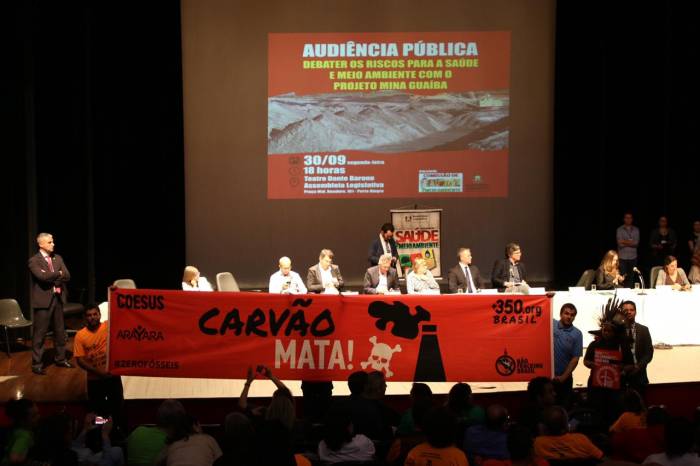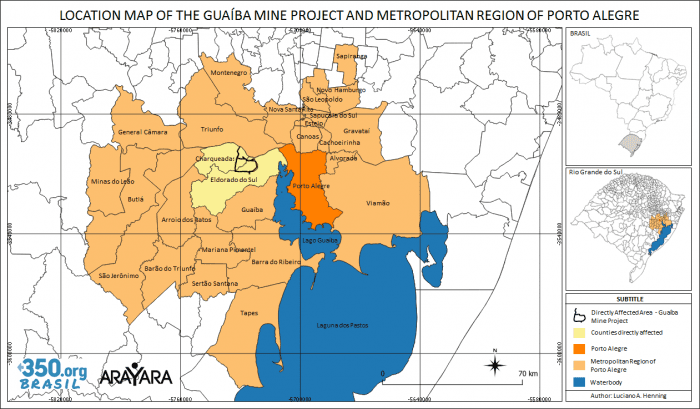Rio Grande do Sul, Brazil’s coal-intensive region, has been the stage of a true David versus Coal-Goliath battle. Copelmi, a coal corporation financed by Banrisul Bank with support of the state government, has been threatening Indigenous communities, family farmers, and fishers with the construction of Guaíba, the largest open-pit coal mine of Latin America.
This mine, located less than 18 miles from the state capital, Porto Alegre, would also endanger the welfare of the 4.5 million people living in the metropolitan area, one of the largest in Brazil.
Guaíba would be developed in the same area of Latin America’s most important organic rice production spot, harming the livelihood of hundreds of small farmers. Artisanal fishers and indigenous villages would also be damaged by potential contamination of the water, lands and air.

These threats were crushed when the Federal Court decided on Friday, February 21 to suspend the environmental license to the mine.
The Federal Justice decision was granted as a response to a request from local Indigenous and environmental organizations, through a Public Civil Action, carried out by the Arayara Institute and the Poty Guarani Indigenous Association. Both were supported by 350.org and the Coal Observatory. The case was preceded by intense discussions in public hearings, marches, lectures and other public activities, as well as the empowerment and mobilization of potentially impacted traditional communities in the metropolitan region.
According to the judge in charge of the case, the main reason for her decision was the fact that the Indigenous communities living in the surroundings of the area where the project would be developed have never been consulted about the enterprise, a mandatory step for this kind of project, according to the Brazilian legislation.
The legal basis for her decision came from the Convention C169 of the International Labor Organization (ILO), of which Brazil is a signatory. It states that Indigenous Peoples must be adequately consulted in advance about decisions that will affect them directly and must offer their consent. This adequate consultation was never made by Copelmi, the company which plans to develop the coal mine.
“People said ‘no’ to this coal mine over and over again,” stated Renan Andrade, 350.org’s Organiser.
Andréia Takua, 350.org’s Indigenous program coordinator, was one of the many people involved in the struggle. In a full house, during a public hearing about the mine at the Legislative Assembly of Rio Grande do Sul, she bravely denounced Copelmi’s intentions to break the law by moving ahead with the license process without consulting impacted Indigenous peoples. She was attacked with racist comments from part of the audience, but she stood up and showed that Indigenous communities are not afraid of fighting for their lives and for nature.
 If the mine had been licensed, the indigenous people of Aldeia Guajayvi could also be forcibly removed. They would have to live with seismic explosions and earthquakes on a daily basis for roughly 30 years, with toxic gas emissions and contaminants. They’d have to breathe particulate materials laden with mercury, would face the degradation of the entire scenic landscape around their territory, and would even face difficulties in obtaining drinking water.
If the mine had been licensed, the indigenous people of Aldeia Guajayvi could also be forcibly removed. They would have to live with seismic explosions and earthquakes on a daily basis for roughly 30 years, with toxic gas emissions and contaminants. They’d have to breathe particulate materials laden with mercury, would face the degradation of the entire scenic landscape around their territory, and would even face difficulties in obtaining drinking water.
Besides the local damage, Mina Guaíba would also aggravate the global climate crisis. It would produce a total of up to 166 million tons of coal, throughout its 27 years of operation, and would be a first step towards installing a slew of factories whose power would be supplied by the coal mine, according to Copelmi.
When the coal would be burned, it’d generate an estimated 4.5 gigatons of carbon dioxide: a huge amount equal to 10% of the world’s annual emissions. That’s according to an estimate made by Dr. Rualdo Menegat, a professor linked to the Institute of Geoscience of UFRGS, the most prestigious university in Rio Grande do Sul.
This is an amazing story of different communities coming together to defeat the Coal Goliath of southern Brazil. People marched, screamed, signed petitions and built people power: and now an enormous quantity of fossil fuel – its emissions, and its direct impacts from extraction – is staying where it belongs: in the ground.
Mina Guaíba’s map

Find out more on social media via #CarvãoAquiNão #MinaGuaíbaNão
Livia Lie – Latin America Digital Campaigner